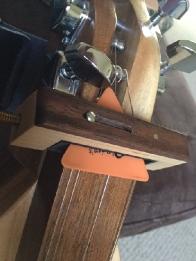Susie:
Dusty,
I need another dulcimer/instrument, like I need a hole in my head. That said (haha), I've told myself, if I were to get one, it would be a McCafferty. I'm happy to see your response, that that would be your choice. Can you post a pic of yours? He makes beautiful dulcimers!
Susie, if someone asks how many dulcimers you need, the right answer is "one more."
I don't want to go too far astray from the original goal of this thread, but it seems reasonable to ask what someone likes about the one dulcimer they identified in response to this forum question.
I bought my McCafferty before he was making radiused fretboards, so I can't speak about that attribute. Terry's dulcimers all have a loud, round, well-balanced tone. The tone resembles a guitar more than the high silvery sound of a traditional dulcimer. The action is excellent and the intonation is superb. One feature of McCafferty dulcimers that I love is the extended strum hollow. Most of us end up strumming over the upper end of the fretboard, and that extended strum hollow allows us to pick and strum there without clacking against the fretboard. Terry uses K & K Sound twin spot pickups inside, and although I don't have too much experience with this stuff, I find them to be phenomenal pickups that provide plenty of amplification without distorting the acoustic tone of the instrument.
Mine is the shortest of the three options Terry offers. The body of all his instruments are the same size, but he makes three different VSLs: 28", 26.5", and 25". I think it is inevitable that you lose a little sustain with a shorter VSL, and were I to buy the instrument now, I might get a 26.5" model. On the other hand, I've already gotten use the shorter VSL and have arranged a few tunes that require stretches I wouldn't be able to make on longer fretboards.
I did have to make one adjustment to the instrument before I felt comfortable flatpicking. The strings are pretty far apart. that works well for fingerpicking and for playing slow tunes, but I found it difficult to flatpick with any speed. I use a single melody string, and the first thing I did was to move that single string to the inside groove on the nut. I then made an extra groove for the bass string that was the same distance away from the middle string. My bass and melody strings are now about 1" apart. I have thought of making a new nut and bridge with grooves that are even closer than that, but for the moment I am doing OK with that distance.
If you go to my video page , you'll see that five of my last six videos were made with my McCafferty dulcimer. And here's a picture of the top. The back and sides are figured cherry and the top is redwood. The inlay is a wolf in front of a full moon with little stars for position dots.

updated by @dusty: 11/19/18 11:03:49PM




 Yesterday alone I played three different dulcimers and two different guitars.
Yesterday alone I played three different dulcimers and two different guitars.  Working on the railroad, dollar and a dime a day/Give my woman the dollar, and throw the dime away
Working on the railroad, dollar and a dime a day/Give my woman the dollar, and throw the dime away




